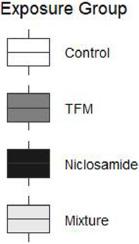Aquatic Toxicology ( IF 4.1 ) Pub Date : 2021-05-01 , DOI: 10.1016/j.aquatox.2021.105848 M J Lawrence 1 , D Mitrovic 2 , D Foubister 2 , L M Bragg 3 , J Sutherby 1 , M F Docker 1 , M R Servos 3 , M P Wilkie 2 , K M Jeffries 1

|
Control of invasive sea lamprey (Petromyzon marinus) in the Laurentian Great Lakes of North America uses lampricides, which consist of 3-trifluoromethyl-4-nitrophenol (TFM) and niclosamide. Lampricides are thought to inhibit aerobic energy synthesis, with TFM having a relatively greater selective action against lampreys. While the toxicity and physiological effects of TFM are known, the impacts associated with exposure to niclosamide and TFM:niclosamide mixtures are poorly characterized in fishes. Therefore, focusing on energy metabolism, we quantified the physiological responses of larval sea lamprey and bluegill (Lepomis macrochirus), a non-target, native species. Exposures consisted of each lampricide alone (TFM at the species-specific 24 h LC10; niclosamide at 1.5% of the mixture's TFM concentration) or a mixture of the two (larval sea lamprey at TFM 24 h LC10 + 1.5% niclosamide; bluegill at sea lamprey's TFM 24 h LC99.9 + 1.5% niclosamide) for 24 h. Tissues (brain, skeletal muscle, and liver) were sampled at 6, 12, and 24 h of exposure and assayed for concentrations of ATP, phosphocreatine, glycogen, lactate, and glucose and tissue lampricide levels. In larval sea lamprey, TFM had little effect on brain and skeletal muscle, but niclosamide resulted in a depletion of high energy substrates in both tissues. Mixture-exposed lamprey showed depletion of high energy substrates, accumulation of lactate, and high mortality rates. Bluegill were largely unaffected by toxicant exposures. However, bluegill liver showed lower glycogen and lactate under all three toxicant exposures suggesting increased metabolic turnover. Bluegill also had lower concentrations of TFM and niclosamide in their tissues when compared to lamprey. Our results indicate that lampricide toxicity in sea lamprey larvae is mediated through a depletion of high energy substrates because of impaired aerobic ATP synthesis. We also confirmed that non-target bluegill showed high tolerance to lampricide exposure, an effect potentially mediated through a high detoxification capacity relative to lampreys.
中文翻译:

对比侵入性海七鳃鳗和非目标蓝鳃鱼对急性杀灭灯剂暴露的生理反应
在北美劳伦斯大湖区控制侵入性海七鳃鳗 ( Petromyzon marinus ) 使用杀灭蚊剂,其由 3-三氟甲基-4-硝基苯酚 (TFM) 和氯硝柳胺组成。Lampricides 被认为会抑制有氧能量的合成,其中 TFM 对七鳃鳗具有相对更大的选择性作用。虽然 TFM 的毒性和生理效应是已知的,但与暴露于氯硝柳胺和 TFM:氯硝柳胺混合物相关的影响在鱼类中的特征很差。因此,我们着眼于能量代谢,量化了海七鳃鳗幼鱼和蓝鳃鱼 ( Lepomis macrochirus )(一种非目标本地物种)的生理反应。暴露仅由每种杀灭灯剂组成(物种特异性 24 小时 LC 10 的TFM; 氯硝柳胺浓度为混合物 TFM 浓度的 1.5%)或两者的混合物(幼体海七鳃鳗,TFM 24 h LC 10 + 1.5% 氯硝柳胺;蓝鳃鱼,TFM 24 h LC 99. 9 + 1.5% 氯硝柳胺)24 小时。在暴露 6、12 和 24 小时时对组织(大脑、骨骼肌和肝脏)进行取样,并测定 ATP、磷酸肌酸、糖原、乳酸、葡萄糖和组织杀灭灯剂水平的浓度。在幼体海七鳃鳗中,TFM 对大脑和骨骼肌几乎没有影响,但氯硝柳胺导致两种组织中高能底物的消耗。混合暴露的七鳃鳗表现出高能量底物的消耗、乳酸的积累和高死亡率。Bluegill 在很大程度上不受有毒物质暴露的影响。然而,蓝鳃鱼肝在所有三种毒物暴露下都显示出较低的糖原和乳酸,表明代谢周转增加。与七鳃鳗相比,蓝鳃鱼的组织中 TFM 和氯硝柳胺的浓度也较低。我们的结果表明,由于有氧 ATP 合成受损,海七鳃鳗幼虫的杀灭灯剂毒性是通过消耗高能底物来介导的。我们还证实,非目标蓝鳃鱼对七鳃鳗暴露有很高的耐受性,这种作用可能是通过相对于七鳃鳗的高解毒能力来介导的。











































 京公网安备 11010802027423号
京公网安备 11010802027423号